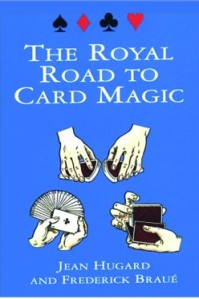
So there you are, with that new copy of The Royal Road to Card Magic that you found under the Christmas tree (or that old copy that you found in your stuff and dusted off because you’re finally ready to get serious about learning magic). Lots of tricks in this book. Lots of good stuff. It’s all neatly arranged to teach card magic from first principles, for the absolute beginner. Everyone recommends this book because … it’s really good.
But what are the best tricks in this book? What to learn cold, to put into your act? For that matter, what is an act?
Each trick has a beginning, a middle, and an end. Tricks are the building blocks of routines.
One way to think of routines is as little stories. Each with a beginning, a middle, and an end. So: a routine is three tricks that lead naturally one into the next. The breaks between tricks in the routine give you time to collect your breath, get back on track if you’ve gotten off, and a place for applause. You like applause. I like applause. Applause is good!
And an act is a set of three routines, each routine forming the beginning, the middle, and the end of the act. (This should run about thirty minutes. Which means, naturally, that if you put together three acts, you have a full evening show.)
An act, thus, is an anthology. (An anthology, btw, is literally “a bouquet of flowers.” In which, if you get a nice bouquet, the blooms will be balanced for size, for color, for texture, for scent, and all those flower-shop virtues.)
These are, in my opinion, the best tricks in Hugard & Braue’s Royal Road to Card Magic. In no particular order:
- A Poker Puzzle
- Acrobatic Aces
- Conus Ace Trick
- The Changing Card
- The Good Luck Card
- The Three Piles
- Double Reverse
- Mirror of the Mind
- Three Cards Across
- Cards to the Pocket
- Fours of a Kind
- Everybody’s Card
- A Tipsy Trick
- Righting a Wrong
- Card in the Pocket
- Obliging Aces
- Piano Trick
- The Sevens
- The Poker Player’s Picnic
- Gathering of the Clan
- Telepathy Plus
- Ladies’ Looking Glass
- Now You See It!
- Topsy-Turvy Cards
- The 26th Card
- Thought Stealer
- Everywhere and Nowhere
- Ambitious Card
- Do as I Do
- Design for Laughter
That’s thirty tricks. Thirty tricks, learned perfectly, and presented well (in accordance with your style and character), are enough to make a career. (Some well-known magicians from the Golden Age of Vaudeville performed far fewer.)
Presentation trumps everything. There is no trick so weak that a sufficiently talented performer can’t turn it into a miracle. And there is no trick so strong that a sufficiently poor performer can’t leave an audience glancing at their watches and eyeing the exits. Don’t use the presentations in the book; they’re too general and, for current tastes, too old-fashioned. Make up your own presentations based on your own character and style.
For far more on style, and characterization, and entertainment in general, get a copy of Henning Nelms’ Magic and Showmanship, new or used, again from your favorite independent bookstore.
Mandatory writing-related comment: A novel has a beginning, a middle, and an end. Novels (usually) consist of chapters, each of which has a beginning, a middle, and an end. Each chapter is built up of scenes, again with beginnings, middles, and ends. And each scene is built from paragraphs, with beginnings, middles, and ends. (Some say, and I can argue that, the paragraph is the smallest unit of meaning in English.)
So: Tricks = paragraphs. Routines = scenes. Acts = chapters. Show = novel. Your typical thirty-minute magic act is the equivalent of a short story.

2 thoughts on “Royal Road”